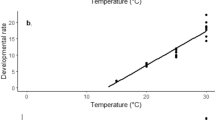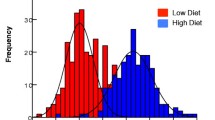Summary
Pupae and fourth instar larvae of a southern (30°N, Alabama, USA) population of Wyeomyia smithii Coq. (Diptera: Culicidae) were collected from pitcher plants. Adults which emerged were maintained without food then dissected to determine their egg clutch size. Among females which matured eggs, fecundities were negatively correlated with larval densities in individual pitchers. The mean autogenous fecundity of the overwintering generation did not differ from a summer sample. Adults unable to mature eggs comprised 6–39% of samples, depending on whether collected as pupae or fourth instar larvae. Fecundity was negatively correlated with time to adult eclosion among larvae maintained on unrenewed pitcher contents in the laboratory.
Cohorts from this population were reared in artificial containers from egg hatch to adulthood at a single density and a superior or inferior diet. On the superior larval diet, all females survived to reproductive age, and all but one (>99%) produced eggs autogenously. On the inferior diet, survivorship to adult eclosion was significantly less, a high proportion of females died before reaching reproductive age, and only 19% of survivors matured eggs without blood. Protracted larval development induced by the inferior diet did not influence the probability of autogeny among females that survived to reproductive maturity.
The relationship between larval environment and reproductive strategies is contrasted across the geographic range of W. smithii. Bloodfeeding occurs among southern populations where density dependent constraints on preimaginal growth are constantly severe. The loss of hematophagy among northern populations may have been facilitated by periods of density independent larval growth.
Similar content being viewed by others
References
Addicott JF (1974) Predation and prey community structure: An experimental study of the effect of mosquito larvae on the protozoan communities of pitcher plants. Ecology 55:475–492
Bradshaw WE (1980) Blood-feeding and capacity for increase in the pitcher-plant mosquito, Wyeomyia smithii. Environ Entomol 9:86–89
Bradshaw WE (1982) Interaction between the mosquito, Wyeomyia smithii, the midge Metriocnemus knabi, and their carnivorous host Sarracenia purpurea. In: Frank JH, Lounibos LP (eds), Phytotelmata: Terrestrial plants as hosts of aquatic insect communities. Plexus Press, Marlton NJ
Bradshaw WE, Holzapfel CM (1982) Life cycle strategies in Wyeomyia smithii: Seasonal and geographic adaptations. In: Brown V, Hodek I (eds) Life cycle strategies. North Holland Publishers, Amsterdam
Bradshaw WE, Lounibos LP (1977) Evolution of dormancy and its photoperiodic control in pitcher-plant mosquitoes. Evolution 31:546–567
Christophers SR (1911) The development of the egg follicle in anophelines. Paludism 2:73–88
Fish D, Hall DW (1978) Succession and stratification of aquatic insects inhabiting the leaves of the insectivorous pitcher-plant, Sarracenia purpurea. Am Midl Nat 99:172–183
Frank JH, Curtis GA (1977) On the bionomics of bromeliad-inhabiting mosquitoes. III. The probable strategy of larval feeding in Wyeomyia vanduzeei and Wy medioalbipes. Mosq News 37:200–206
Hudson A (1970) Notes on the piercing mouth parts of three species of mosquitoes (Diptera: Culicidae) viewed with the scanning electron microscope. Can Entomol 102:501–509
Istock CA, Wasserman SS, Zimmer H (1975) Ecology and evolution of the pitcher-plant mosquito: 1. Population dynamics and laboratory responses to food and population density. Evolution 29:296–312
Istock CA, Vavra KJ, Zimmer H (1976) Ecology and evolution of the pitcher-plant mosquito. 3. Resource tracking by a natural population. Evolution 30:548–557
Kingsolver JG (1979) Thermal and hydric aspects of environmental heterogeneity in the pitcher-plant mosquito. Ecol Monogr 49:357–376
Lang JT (1978) Relationship of fecundity to the nutritional quality of larval and adult diets of Wyeomyia smithii. Mosq News 38:396–403
Lloyd M (1967) Mean crowding. J Anim Ecol 36:1–30
Moeur JE, Istock CA (1980) Ecology and evolution of the pitcherplant mosquito. IV. Larval influence over adult reproductive performance and longevity. J Anim Ecol 49:775–792
O'Meara GF (1979) Variable expressions of autogeny in three mosquito species. Int J Inv Repro 1:253–261
O'Meara GF, Lounibos LP, Brust RA (1981) Repeated egg clutches without blood in the pitcher-plant mosquito. Ann Entomol Soc Am 74:68–72
O'Meara GF, Lounibos LP (1981) Reproductive maturation in the pitcher-plant mosquito, Wyeomyia smithii. Physiol Entomol 6:437–443
Paterson CG (1971) Overwintering ecology of the aquatic fauna associated with the pitcher-plant, Sarracenia purpurea L. Can J Zool 49:1455–1459
Scott JA, McClelland GAH (1977) A model of polymorphism with several seasons and several habitats, and its application to the mosquito Aedes aegypti. Theor Popul Biol 11:342–355
Seifert RP (1980) Mosquito fauna of Heliconia aurea. J Anim Ecol 49:687–697
Smith SM, Brust RA (1971) Photoperiodic control of maintenance and termination of larval diapause in Wyeomyia smithii (Coq.) (Diptera: Culicidae) with notes on oogenesis in the adult female. Can J Zool 49:1065–1073
Sokal RR, Rohlf FJ (1969) Biometry. WH Freeman, San Francisco
Spielman A (1971) Bionomics of autogenous mosquitoes. Ann Rev Entomol 16:231–248
Wilbur HA (1980) Complex life cycles. Ann Rev Ecol Syst 11:67–93
Williams CM, Kafatos FC (1971) Theoretical aspects of the action of juvenile hormone. Mitt Schweiz Entomol Ges 44:151–162
Author information
Authors and Affiliations
Additional information
Institute of Food and Agricultural Sciences, University of Florida, Experimental Station Journal Series No. 3645
Rights and permissions
About this article
Cite this article
Lounibos, L.P., Van Dover, C. & O'Meara, G.F. Fecundity, autogeny, and the larval environment of the pitcher-plant mosquito, Wyeomyia smithii . Oecologia 55, 160–164 (1982). https://doi.org/10.1007/BF00384482
Received:
Issue Date:
DOI: https://doi.org/10.1007/BF00384482




